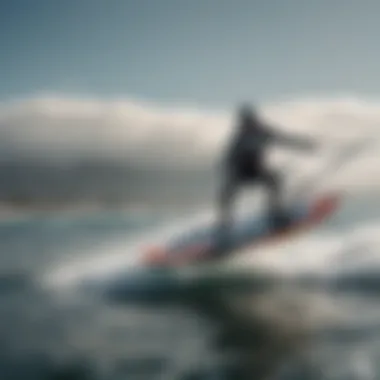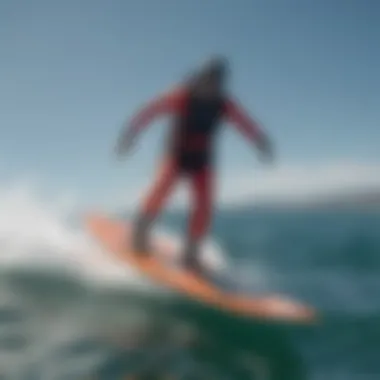Unveiling the Intricacies of Hydrofoil Boards: A Comprehensive Exploration


Equipment Reviews
Hydrofoil boards have revolutionized the world of surfing and watersports, pushing the boundaries of performance and efficiency. To fully grasp the intricacies of these cutting-edge boards, it is essential to delve into the components that make up the perfect setup. From kites to boards and accessories, each element plays a crucial role in maximizing the hydrofoil experience. Let's explore the key aspects that enthusiasts should consider when assembling their hydrofoil kit.
Kites: Unraveling the Realm of Aerial Mastery
Kites are the power source behind hydrofoil boards, harnessing the wind's energy to propel riders across the water's surface. The latest kite models boast innovative features and designs tailored to elevate performance and maneuverability. By investigating various kite shapes, sizes, materials, and brands, riders can pinpoint the ideal kite that aligns with their riding style and skill level. From delta shapes to hybrids, the diversity in kite designs offers a spectrum of options for riders seeking optimal control and lift.
Boards: Crafting the Perfect Ride
While kites generate the thrust, boards are the cornerstone of stability and control in hydrofoil endeavors. From twintips designed for freestyle tricks to directional boards optimized for wave riding, the world of kiteboarding boards offers a plethora of options to suit different riding preferences. Analyzing the design, construction, and riding style suitability of various boards is paramount in selecting the board that harmonizes with the rider's skill level and desired experience on the water. Understanding the nuances between different board types is essential in unlocking the full potential of hydrofoil boarding.
Accessories: Elevating Safety and Performance
Beyond kites and boards, the role of accessories in enhancing safety and performance cannot be understated. Essential kiteboarding accessories such as harnesses, lines, pumps, and safety gear form a critical part of the rider's kit. Each accessory serves a specific function, ensuring riders can navigate the waters with confidence and precision. By delving into the importance of harnesses for weight distribution, lines for steering control, pumps for inflating kites, and safety gear for emergency situations, riders can gain a comprehensive understanding of the gear required for a seamless hydrofoil experience.
Introduction to Hydrofoil Boards
In this section, we embark on a detailed exploration of the intricate world of hydrofoil boards, enlightening readers on the underlying mechanisms dictating their operations. Hydrofoil boards, remarkable in their design and functionality, serve as a pinnacle of innovation in the realm of water sports. Understanding the nuances of these boards is crucial for enthusiasts looking to delve into the exhilarating world of hydrofoil surfing. By dissecting the core principles governing hydrofoil boards, we aim to shed light on their significance and unparalleled capabilities.
What Are Hydrofoil Boards?
Hydrofoil boards, also known as foil boards, represent a revolutionary advancement in water sports equipment. These specialized boards feature a hydrofoil mounted beneath the surface, enabling them to lift out of the water as speed increases. This lift effect, facilitated by the hydrofoil, results in reduced drag and enhanced maneuverability, providing riders with a thrilling and unique surfing experience. The distinct design of hydrofoil boards sets them apart from traditional surfboards, making them a coveted choice among adrenaline-seeking individuals.
Brief History of Hydrofoil Technology
The evolution of hydrofoil technology traces back to the early 20th century, marked by continuous experimentation and innovation. Pioneered by visionaries seeking to transcend the limitations of conventional surfboards, hydrofoil technology has undergone significant refinement over the years. From rudimentary designs to cutting-edge engineering feats, the journey of hydrofoil boards reflects a relentless pursuit of performance and efficiency. By exploring the historical trajectory of hydrofoil technology, we can appreciate the strides made in optimizing the functionality and design of these exceptional watercraft.
Key Components of a Hydrofoil Board


A hydrofoil board comprises several essential components that synergistically contribute to its enhanced performance. The primary elements include the hydrofoil itself, which generates lift and stability, the board deck providing rider support, and the mast connecting the foil to the board. Additionally, specialized wings attached to the foil play a pivotal role in maneuvering and maintaining balance on the board. Understanding the intricate interplay of these components is critical for enthusiasts looking to harness the full potential of hydrofoil boards. By delving into the key components of these innovative boards, we can grasp the complex yet fascinating blend of engineering and athleticism that characterizes hydrofoil surfing.
Principles of Hydrofoil Operation
Understanding the principles of hydrofoil operation is crucial in comprehending the functionality of hydrofoil boards. This section delves deep into the scientific underpinnings that govern how hydrofoils work on water surfaces. By exploring the role of lift and drag, readers can grasp the fundamental concepts that enable hydrofoil boards to navigate efficiently through different water conditions. Key elements such as foil design and hydrodynamics play a pivotal role in enhancing the performance and maneuverability of hydrofoil boards, making this topic integral to the overarching exploration of hydrofoil technology.
Understanding Lift and Drag in Hydrofoil Boards
In the realm of hydrofoil boards, the interaction between lift and drag is paramount to their operation. Lift, generated by the foils beneath the board, allows the craft to rise above the water, reducing drag and increasing speed. The Role of Hydrodynamics underscores the intricate balance between lift and drag, shaping the hydrofoil's efficiency. Additionally, the Effect of Foil Design significantly influences how lift and drag are managed, affecting the overall performance of the hydrofoil board. Different foil designs offer varying levels of lift and drag, each with its own set of advantages and disadvantages that impact the board's performance.
Role of Hydrodynamics
The Role of Hydrodynamics in hydrofoil operation is immense. It determines how efficiently the foils generate lift, counteracting the drag force to propel the board forward. By optimizing hydrodynamic principles, engineers can design foils that minimize drag and maximize lift, thereby enhancing the maneuverability and responsiveness of hydrofoil boards. The unique feature of hydrodynamics lies in its ability to streamline water flow around the foils, reducing resistance and allowing for smoother gliding. While hydrodynamics offer significant advantages in terms of speed and efficiency, complexities in design and maintenance may pose challenges in certain conditions.
Effect of Foil Design
When it comes to hydrofoil boards, the Effect of Foil Design is a critical aspect to consider. The shape, size, and material composition of the foils directly impact the lift and drag forces experienced by the board. An optimal foil design can increase stability, control, and overall performance, making it a preferred choice for enthusiasts seeking superior hydrofoil experiences. The unique feature of foil design lies in its versatility to cater to different riding styles and preferences. While certain designs may prioritize speed, others focus on stability and maneuverability, presenting a trade-off between various advantages and disadvantages based on the rider's skill level and objectives.
Hydrofoil Board Maneuverability
Maneuverability is a key attribute that distinguishes hydrofoil boards from conventional watercraft. By mastering turning techniques and understanding stability factors, riders can navigate their boards with precision and agility. This section sheds light on the mechanics behind efficient board control, essential for both recreational enjoyment and competitive performance.
Turning Techniques
Effective Turning Techniques are essential for maneuvering hydrofoil boards with finesse and control. By shifting body weight, adjusting foot positioning, and utilizing foil tilt, riders can execute smooth turns and directional changes while maintaining stability. The key characteristic of turning techniques lies in their influence on board responsiveness and agility, allowing riders to carve through water with precision. This technique is a popular choice among experienced riders due to its ability to enhance overall performance and create dynamic riding experiences.
Stability Factors
Stability Factors play a crucial role in ensuring rider safety and comfort on hydrofoil boards. Factors such as foil size, wing configuration, and rider positioning contribute to the board's overall stability in varying water conditions. By optimizing these stability factors, riders can minimize the risk of instability or falls, enabling smoother rides and increased confidence on the water. The key characteristic of stability factors is their ability to influence rider balance and control, enhancing the overall hydrofoil experience. While stability factors offer several advantages in terms of safety and ease of use, they may also limit advanced maneuvers for riders seeking high-performance capabilities.
Impact of Rider Skills on Hydrofoil Performance


The performance of a hydrofoil board is intricately linked to the skills and abilities of the rider. This section explores how rider proficiency influences the overall dynamics and efficiency of hydrofoil operation, highlighting the symbiotic relationship between rider and board in achieving optimal performance.
The Role of Hydrodynamics
Hydrodynamics play a crucial role in the functionality and performance of hydrofoil boards. Understanding the dynamics of fluid flow is essential for optimizing efficiency and maneuverability. By delving into the intricacies of hydrodynamics, riders can unlock the full potential of their hydrofoil setups. Factors such as lift, drag, and foil design are deeply influenced by hydrodynamic principles, making it a foundational element in hydrofoil technology.
Fluid Dynamics in Hydrofoil Operation
Bernoulli's Principle
Bernoulli's Principle is a fundamental concept that explains the relationship between fluid speed and pressure. In the context of hydrofoil boards, this principle elucidates how variations in water velocity affect lift force generation. By comprehending Bernoulli's Principle, riders can strategically adjust their approach to different water conditions, thereby enhancing their overall performance. The utilization of this principle enables precise control over lift dynamics, optimizing efficiency and speed on the water.
Boundary Layer Control
Boundary Layer Control is another critical aspect of fluid dynamics that significantly impacts hydrofoil operation. This control mechanism involves managing the thin layer of fluid near the foil surface to reduce drag and improve overall performance. By effectively regulating boundary layer conditions, riders can minimize resistance and maximize speed. Implementing boundary layer control strategies empowers riders to enhance stability and maneuverability, ultimately elevating their hydrofoil experience.
Effect of Water Conditions on Hydrofoil Performance
Impact of Wind Speed
Wind speed is a key environmental factor that directly influences hydrofoil performance. Understanding how wind speed affects water dynamics is paramount for riders seeking to optimize their efficiency and control on the water. By assessing the impact of wind speed on hydrofoil boards, riders can adapt their techniques to varying conditions, ensuring a stable and productive ride. Addressing this factor resonates with riders aiming for consistency and performance consistency in dynamic environments.
Water Turbulence
Water turbulence poses unique challenges to hydrofoil operation, impacting stability and control during rides. Recognizing the characteristics of water turbulence allows riders to adjust their approach accordingly, mitigating potential disruptions to their performance. By navigating through turbulent waters with skill and precision, riders can harness the power of hydrodynamics to maintain balance and control. Managing water turbulence effectively is key to mastering the art of hydrofoil boarding.
Optimizing Hydrofoil Efficiency
Foil Shape
The shape of the foil plays a significant role in determining hydrofoil efficiency and performance. Different foil shapes offer varying levels of lift, drag, and stability, influencing the overall ride experience. By selecting an appropriate foil shape based on riding style and preferences, riders can customize their setup to suit their specific needs. Understanding the characteristics of different foil shapes is crucial for optimizing efficiency and achieving peak performance.


Adjusting Angle of Attack
Fine-tuning the angle of attack is a critical adjustment that directly affects hydrofoil performance. By modifying the angle of attack, riders can control the lift and drag forces acting on the foil, optimizing efficiency and maneuverability. This adjustment provides riders with the flexibility to adapt to changing water conditions and riding styles, enhancing their ability to navigate diverse environments with confidence. Mastering the art of adjusting the angle of attack is key to unlocking the full potential of hydrofoil boards.
Innovations in Hydrofoil Technology
In the realm of hydrofoil boards, innovations in technology play a pivotal role in shaping the landscape of this sport. The constant evolution and enhancements in materials, design, and technology have revolutionized the performance and functionality of hydrofoil boards. By incorporating cutting-edge innovations, hydrofoil manufacturers aim to push the boundaries of what these boards can achieve. This article will delve into the significance of these innovations and how they contribute to the overall advancement of hydrofoil technology.
Advancements in Materials and Design
Carbon Fiber Foils
Carbon fiber foils represent a significant advancement in hydrofoil technology due to their exceptional strength-to-weight ratio. The specific aspect of carbon fiber foils lies in their lightweight composition coupled with remarkable durability, which enhances the overall performance of hydrofoil boards. The key characteristic of carbon fiber foils is their rigidity, which allows for precise maneuverability and responsiveness in various water conditions. This feature makes carbon fiber foils a popular choice among enthusiasts seeking high performance and reliability in their hydrofoil experience. Despite being a top-tier material, carbon fiber foils do come with a higher price tag, but the advantages they offer in terms of performance and durability outweigh the cost considerations.
Hybrid Construction
Hybrid construction is another innovative approach in hydrofoil design that combines the best of multiple materials to achieve optimal performance. The key characteristic of hybrid construction is its ability to leverage the strengths of different materials, such as carbon fiber and aluminum, to create a foil that is both lightweight and robust. This design choice not only enhances the durability of the hydrofoil but also improves its overall efficiency in the water. The unique feature of hybrid construction lies in its versatility, allowing manufacturers to tailor the foils to specific performance requirements while maintaining structural integrity. However, the complexity of hybrid construction may lead to higher production costs, but the benefits it brings in terms of performance customization and longevity make it a valuable investment for serious riders.
Integration of Technology in Hydrofoil Boards
Electronic Stability Control
The integration of electronic stability control systems in hydrofoil boards marks a significant milestone in enhancing rider experience and safety on the water. Electronic stability control systems offer a key characteristic of automatically adjusting foil angles to maintain stability and prevent accidents during challenging maneuvers. This feature is a beneficial choice for riders looking to enhance their skills without compromising on safety. The unique feature of electronic stability control systems is their real-time response to changing water conditions, providing riders with a seamless and controlled ride. While electronic stability control systems add a layer of sophistication to hydrofoil boards, some riders may find them less suitable for those who prefer a hands-on approach to foiling.
Wireless Connectivity
Wireless connectivity in hydrofoil boards streamlines the interaction between riders and their equipment, offering a seamless riding experience. The key characteristic of wireless connectivity is its ability to provide instant performance data feedback to riders, allowing them to make real-time adjustments for optimal performance. This feature is a popular choice for tech-savvy riders who value data-driven insights to enhance their foiling skills. The unique feature of wireless connectivity lies in its convenience and accessibility, enabling riders to monitor their performance metrics effortlessly. Despite its advantages, wireless connectivity may face limitations in areas with poor signal reception, impacting data transmission and analysis.
Future Prospects for Hydrofoil Industry
Environmental Sustainability
The focus on environmental sustainability in the hydrofoil industry reflects a growing commitment to reducing the ecological footprint of hydrofoil manufacturing and usage. Environmental sustainability offers a key characteristic of using eco-friendly materials and production processes to minimize environmental impact. This aspect is a beneficial choice for riders concerned about their environmental responsibility while enjoying the sport. The unique feature of environmental sustainability is its long-term impact on preserving natural habitats and marine ecosystems, fostering a greener approach to hydrofoil boarding. While environmental sustainability brings clear advantages in terms of conservation efforts, the transition to sustainable practices may require initial investments and adjustments in production techniques.
Performance Enhancements
Performance enhancements in hydrofoil technology continually strive to improve the speed, agility, and overall capabilities of hydrofoil boards. The key characteristic of performance enhancements is their focus on optimizing foil geometries, wing shapes, and stabilizers to achieve peak performance levels. This pursuit of excellence is a beneficial choice for riders seeking to push the boundaries of their riding abilities and explore new frontiers in hydrofoil sports. The unique feature of performance enhancements is their ability to unlock higher speeds, smoother maneuvers, and enhanced stability, delivering an unparalleled riding experience. However, the pursuit of performance enhancements may come with trade-offs in terms of increased complexity or specialized maintenance requirements, requiring riders to balance performance gains with practical considerations.







